Contents
How common is fraud and how does it affect the bottom line of online marketplaces? We asked more than 700 people in Europe, North America, and Australia about how fraudulent listings and content quality affect their trust and willingness to purchase.
Marketplaces are sites like Amazon, eBay, Rakuten, and Zalando. There are both sellers and buyers. Product listings often have images, text descriptions, and sometimes reviews and testimonials. Due to the nature of these platforms, they have a lot of user-generated content (UGC), making it challenging to keep the experience safe and well-moderated for end users.
Many of the findings and examples in this survey apply to e-commerce in general, although the questions were asked within the context of online marketplaces (i.e., a subset of e-commerce, you could say).
We were above all interested in learning more about trust and safety on these platforms as it pertains to their end users, especially their buyers. How common is fraud, and how many are affected by it? What kind of content in listings inspires trust and willingness to purchase?
Ultimately, for these platforms, it is vital that end users can trust their content and that they can buy products with confidence. We have worked with content moderation for all kinds of platforms over the years, so it’s a subject that’s near and dear to our hearts.
In total, 703 people completed our survey, so we got a decent sample base. But it’s also worth keeping in mind that there are literally billions of people on the internet, and a few hundred people are not going to be a perfect representation of that.
Of the people responding to the survey, the vast majority were based in North America and Europe, which is also something to keep in mind when looking at the results.
A few interesting takeaways from this survey
This is all related to the usage of online marketplaces, based on responses from 703 people:
- 80% have at some point avoided purchasing a product due to concerns about the trustworthiness of a listing.
- 40% have at some point been scammed by a fraudulent listing, for example, not receiving an item or receiving a very different item from what they ordered.
- 58% have at some point come upon fraudulent or misleading listings on an online marketplace.
- 92% consider good product images to be important for trusting a listing.
- 92% consider good product descriptions to be important for trusting a listing (yes, the same as for images).
- 86% consider reviews to be important for trusting a listing.
- 93% are positive to content moderation (rated their opinion as 3/5 or higher). 60% rated it 4 or 5 out of 5.
- 54% are unaware of the content moderation policies on the platforms they use.
There is a lot more to it than just a few handpicked data points, so read on for plenty of charts and observations based on the data we collected in this survey.
How common is fraud on online marketplaces?
Nobody likes to be scammed, and it can seriously hurt someone’s willingness to continue shopping at a specific online marketplace or store. Of the people we asked, 40% have at some point been scammed while using an online marketplace. That is a depressingly high number.
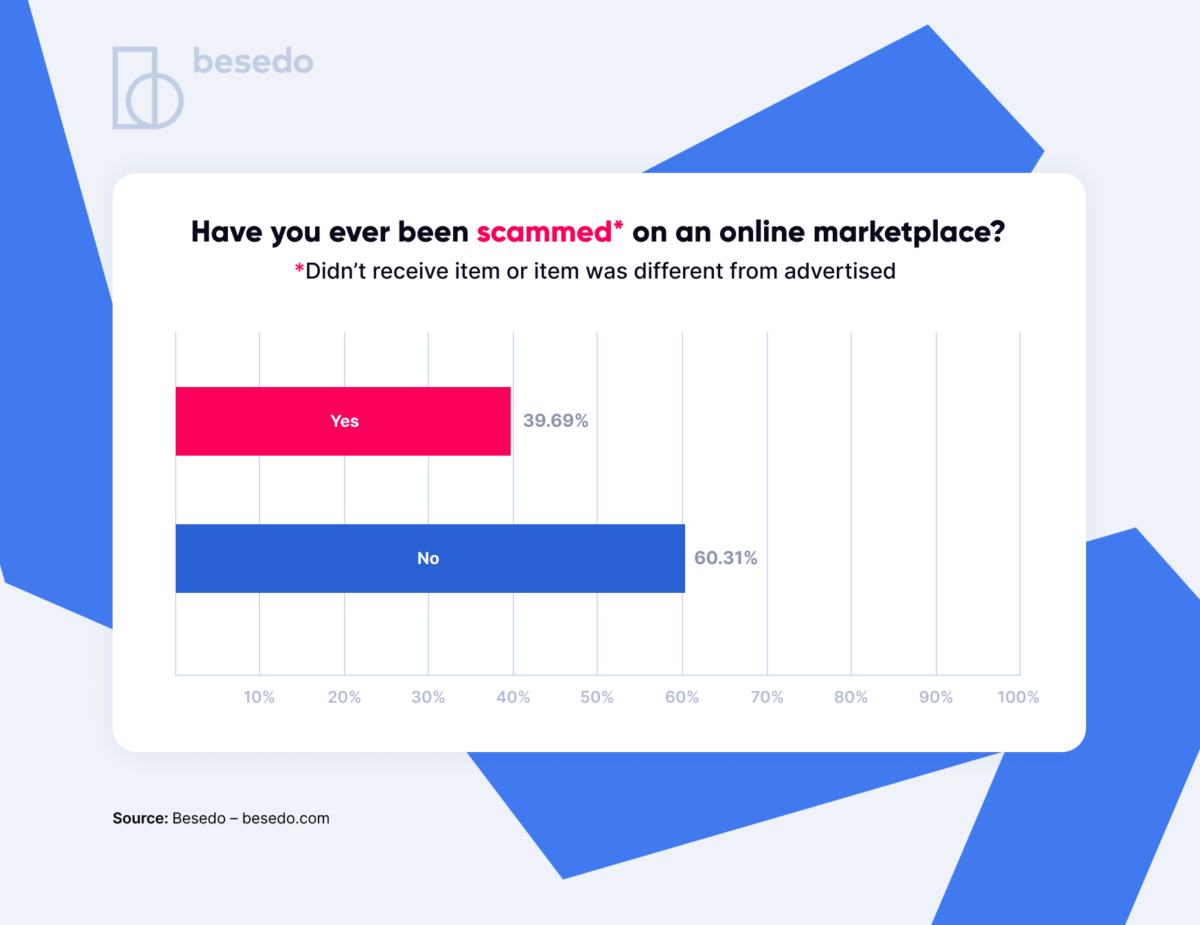
That is 2 in 5 people that have at some point, at least once, had a negative experience with an online marketplace. This can hurt trust in a brand for a long time.
The number climbs up a lot higher if we ask how many people have found misleading or fraudulent listings on marketplaces. More than 58% of the respondents said yes to this.
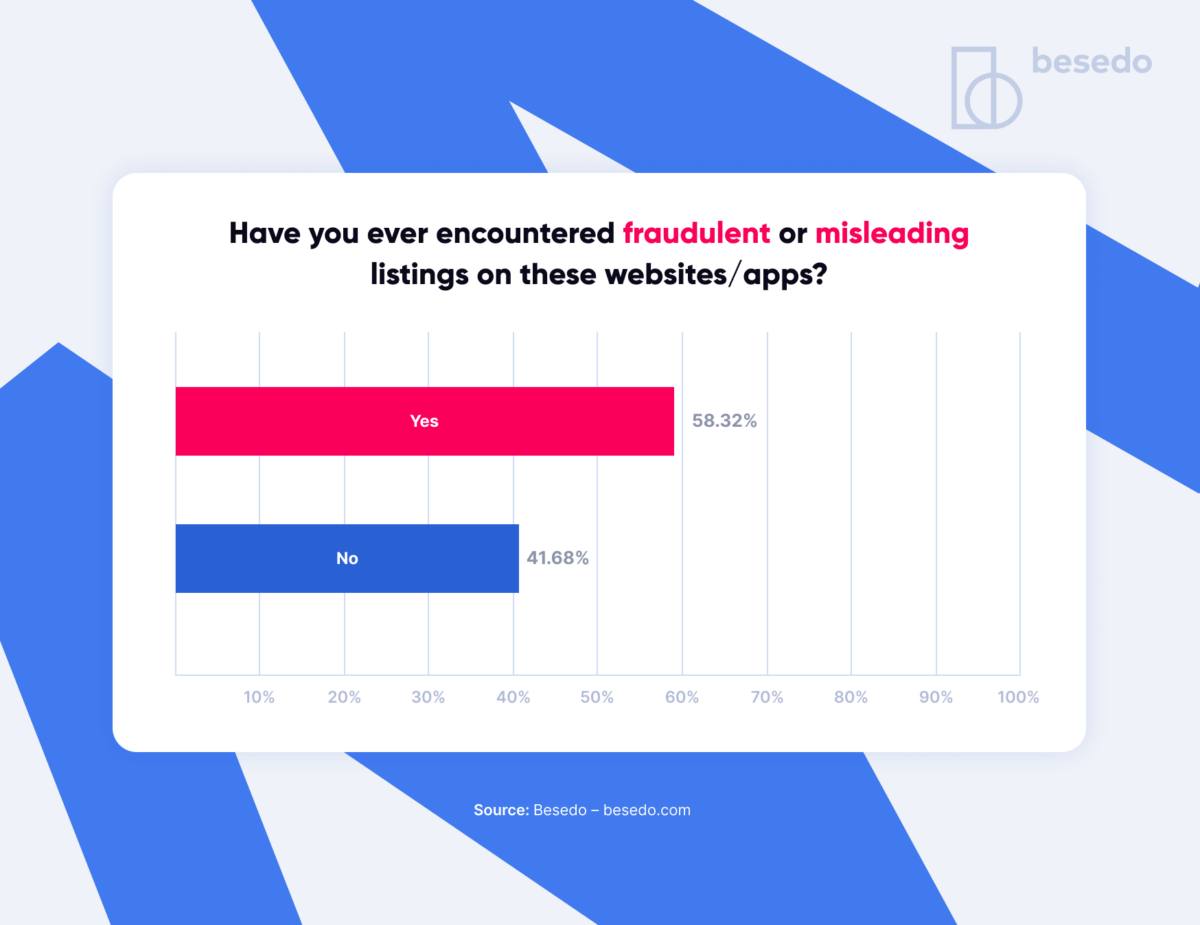
It should be noted that this is what people self-reported as noticed. It doesn’t mean the people who replied “no” to this question haven’t been exposed to fraudulent listings. It just means that they haven’t identified or noticed them.
With that in mind, it’s not surprising that the vast majority of the people we asked viewed content moderation on marketplaces in a positive light. (More about that later in this report.)
How trust affects marketplace revenue
This is of course critical for the viability of a platform: If buyers don’t trust the sellers enough, and therefore by association not the platform, there will be real money lost.
A whopping 80% of the survey respondents said they had avoided purchasing something because they didn’t find the listing trustworthy. It is, in other words, a pervasive experience that affects the decision-making of four out of five consumers.
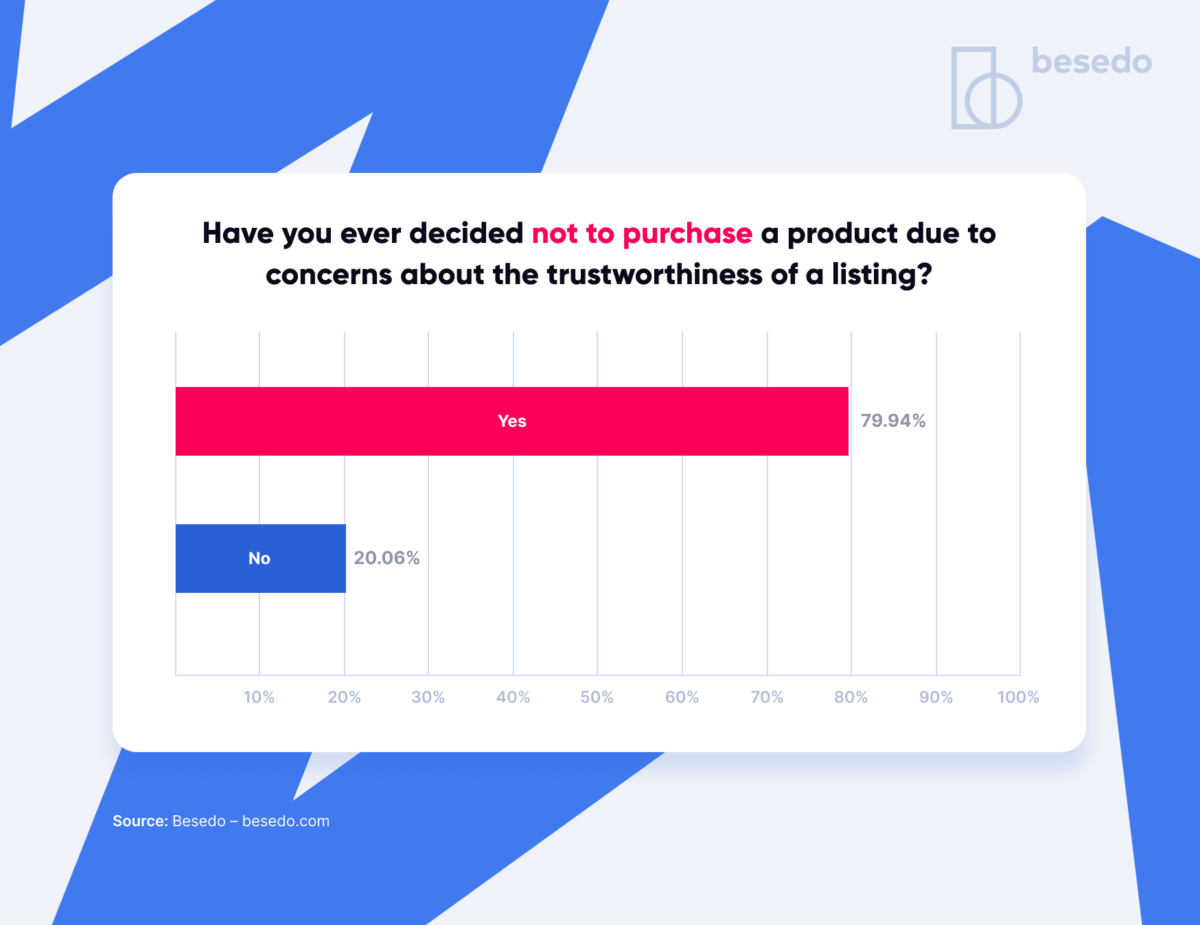
Considering how that is a direct threat to the revenue of a platform, and its other sellers, ensuring high-quality listings should be a top priority. Not to mention that it most likely hurts the brand significantly long term, which is a result that is more difficult to measure but nonetheless critical to business success.
The exact impact on the bottom line is bound to vary based on a number of factors, but we don’t think anyone can look at these numbers and conclude they don’t do any harm.
What makes people trust a marketplace listing?
This will, of course, depend on the specifics of the marketplace in question, the product or service sold, and so on, but in general, listings tend to have a few commonalities:
- Product images or photos
- Product description texts
- Product reviews
To anyone in e-commerce, these three are always there, top of mind.
The Trifecta of Trust for product listings
The reason we asked specifically about the importance of product images, descriptions, and reviews is because we know they are important factors that affect conversion rates for e-commerce in general.
It may be a bit tongue in cheek, but we decided to call this trio of features the Trifecta of Trust for product listings. So how important are they relative to each other?
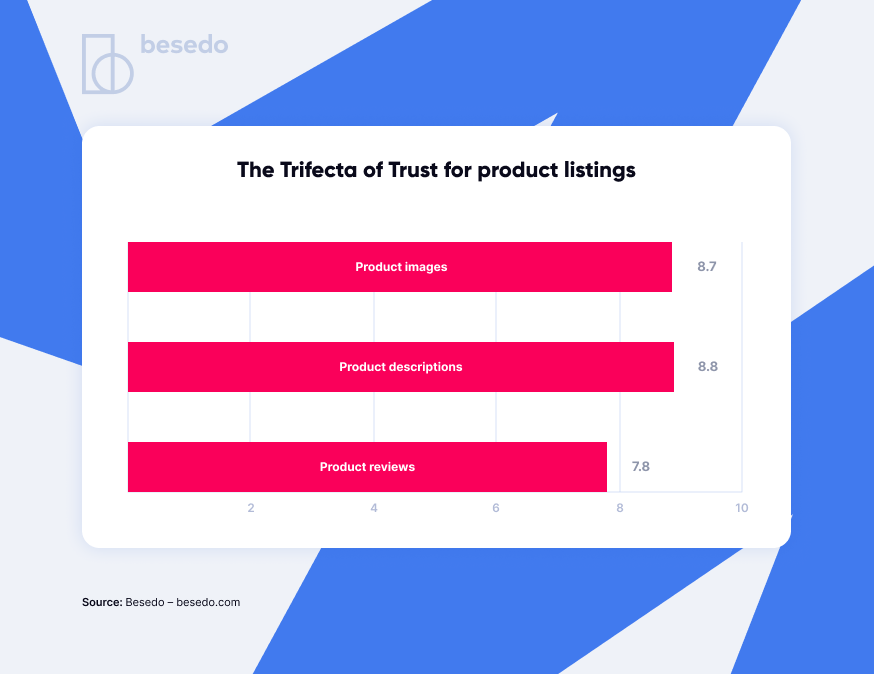
All three are clearly considered very important by the average buyer, so this is just a comparison based on the responses we got in this survey in one easy chart.
We go into more detail about the responses here below.
How important are good product images?
Good product images are clearly something buyers place a lot of importance on. The average rating was 8.7 out of 10, where 1 is “not important” and 10 is “very important”.
The exact question we asked was: “How important are high-quality, accurate, and detailed product images in establishing trust in a listing?”
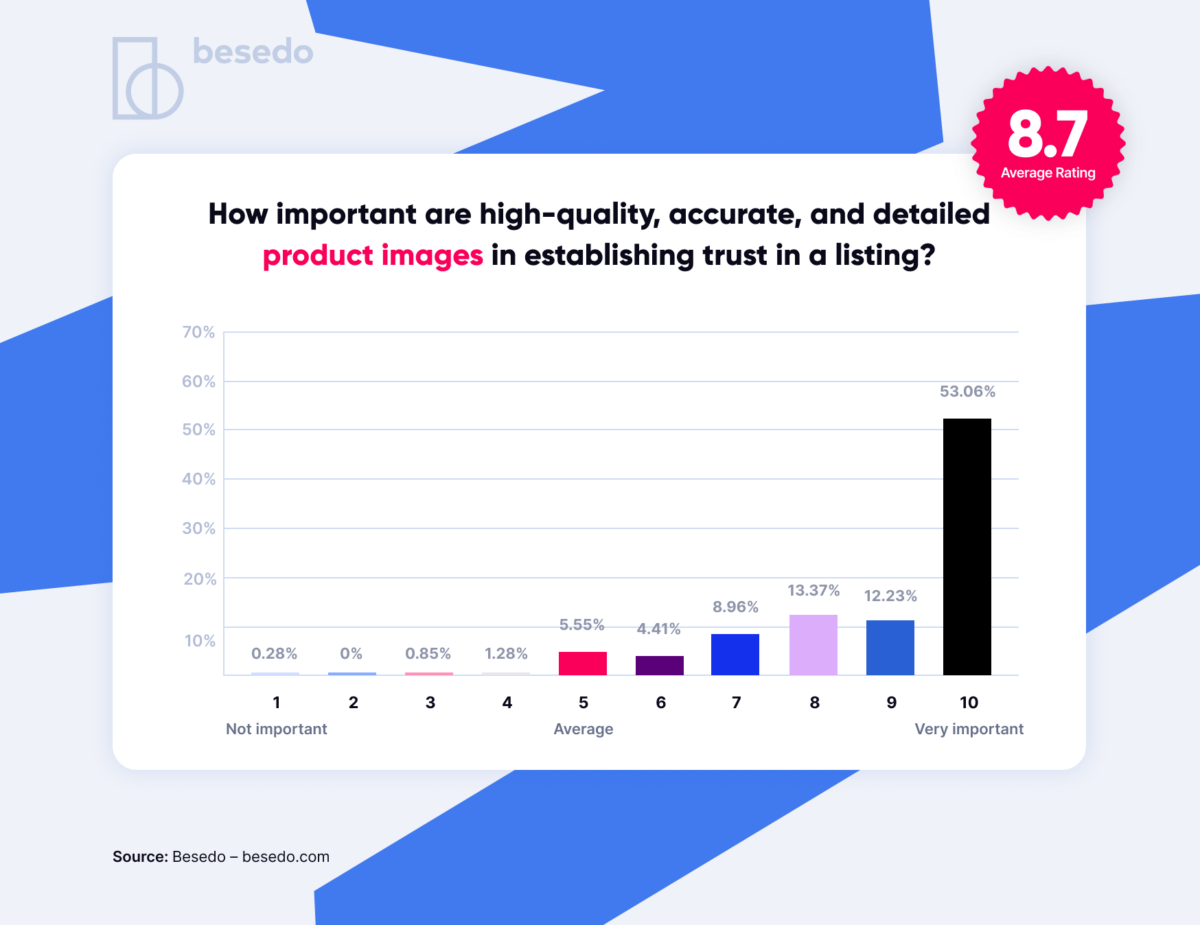
A few observations about the importance of good product images:
- 53% rated this 10/10, i.e., more than half of the respondents gave good images maximum importance.
- 92% rated the importance of good images a 6 or higher.
Only 2.4% rated the importance of good images a 4 or lower.
How important are good product descriptions?
Images alone are not enough. Good product descriptions matter a great deal as well. In fact, they had the highest average rating with 8.8 out of 10.
The exact question we asked was: “How important are clear and accurate product descriptions in establishing trust in a listing?”
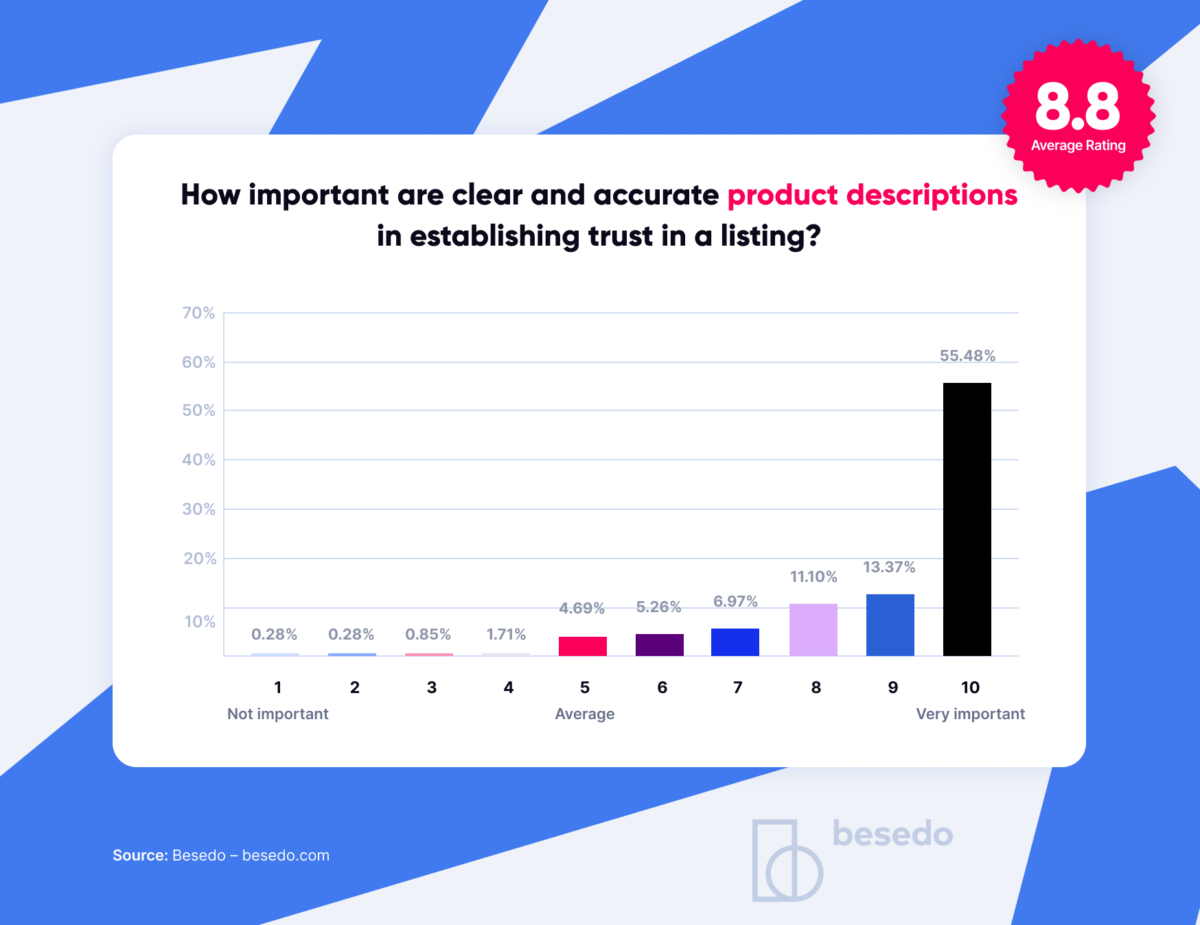
A few observations about the importance of good product descriptions:
- More than 55% rated this 10/10, i.e., they gave product descriptions maximum importance.
- 92% rated the importance of product descriptions a 6 or higher. That’s the same sum as for good images, though divided differently (more towards 10).
- Only 3.1% rated the importance of good descriptions a 4 or lower.
In a later, freeform question about what made them distrust a listing, many of the respondents cited bad grammar and spelling, as well as vague descriptions, as red flags.
How important are reviews?
Customer reviews and testimonials, although not quite as highly rated as good product images and descriptions, clearly add a lot of value to a listing. The average rating was 7.8 out of 10, where 1 is “not important” and 10 is “very important”.
The exact question we asked was: “To what extent do customer reviews and testimonials impact your trust in a listing?”
Interestingly, while good images and descriptions had a lot of respondents give them an importance of 10/10 (over half of the respondents did this), the opinions on reviews are less clear-cut. Compare this chart with the others and it becomes obvious.
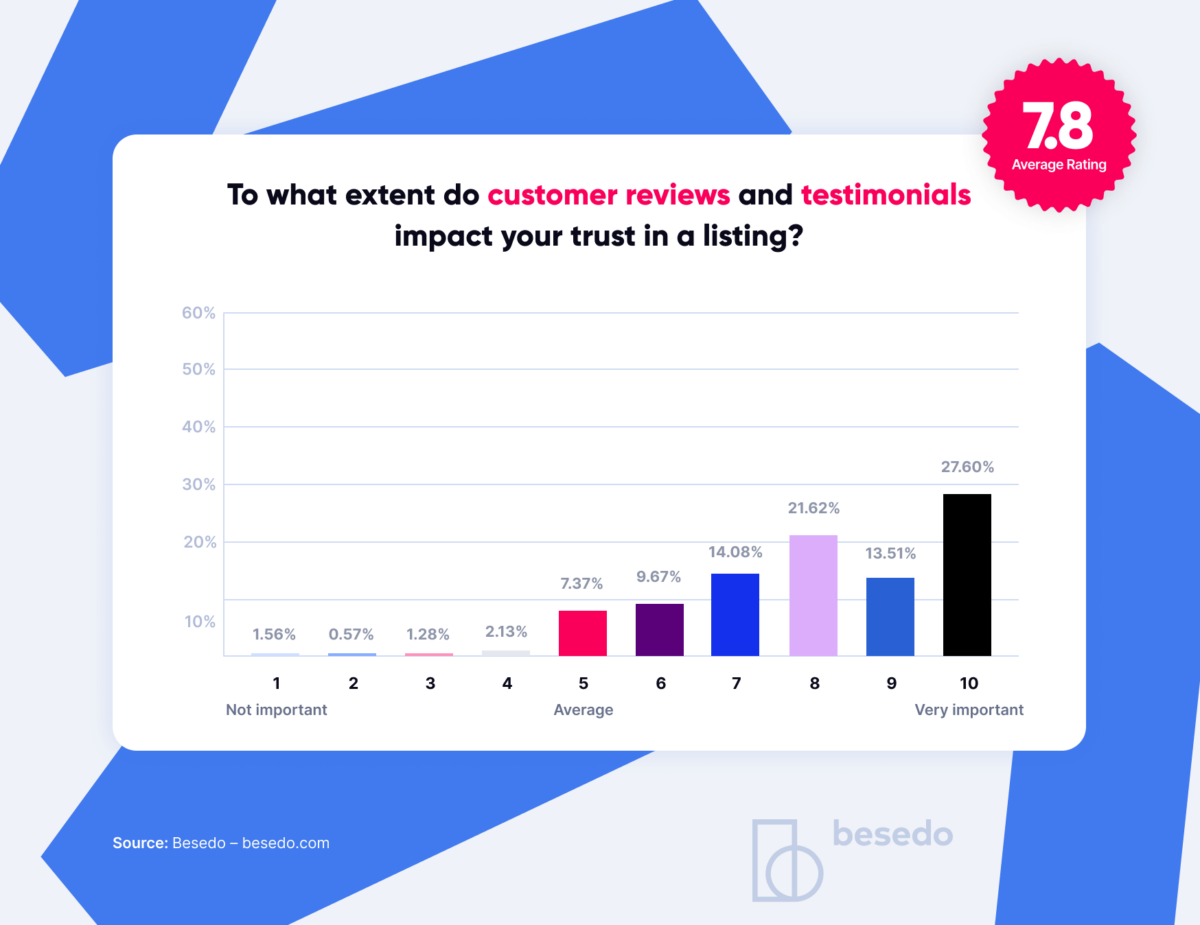
A few observations about the importance of customer reviews and testimonials:
- 28% (27.6% to be precise) gave this a 10/10. That’s about half of what was given to images and descriptions. This could indicate that they are slightly less of a dealbreaker to the average consumer.
- 86% rated the importance of reviews a 6 or higher. For images and descriptions, this number was 92%.
- 5.5% rated the importance of reviews a 4 or lower. This is a very small percentage but still around double compared to the equivalent sentiments for good images and descriptions.
In a freeform question we got two common types of replies: Reviews that were all full marks, and all of them similar, indicating fake reviews were a red flag. And, of course, also poor reviews of either the product or the seller.
What makes people distrust a marketplace listing?
On the flipside of trust we have distrust. People shop online all the time these days, and many are understandably wary of whom to trust. Many have been burned by negative experiences or outright scams, or know of others who have.
In addition to what we asked about the importance of product images, descriptions, and reviews, we had a freeform question at the end of the survey where we let people explain what would make them not trust a listing, especially if it was something we hadn’t brought up already.
Not everyone responded, but of those who did:
- Many mentioned bad grammar or some version of poor language in general, such as poor spelling. Also, vague or missing descriptions were a red flag. (People really care about those product descriptions.)
- Another common red flag was pricing, especially if it seems too good to be true.
- Many mentioned negative reviews or negative feedback about the seller, but in some cases also ratings that are too perfect, all five stars and very similar, are also red flags.
- If there are no reviews at all.
- Bad or blurry photos, or even inaccurate photos that don’t represent the product.
- Fake profiles were also a recurring theme, and brand new accounts. We assume this was in reference to sellers.
- Some also listed “sketchy” sellers as things they looked out for.
The word cloud for the aggregated replies is quite telling.
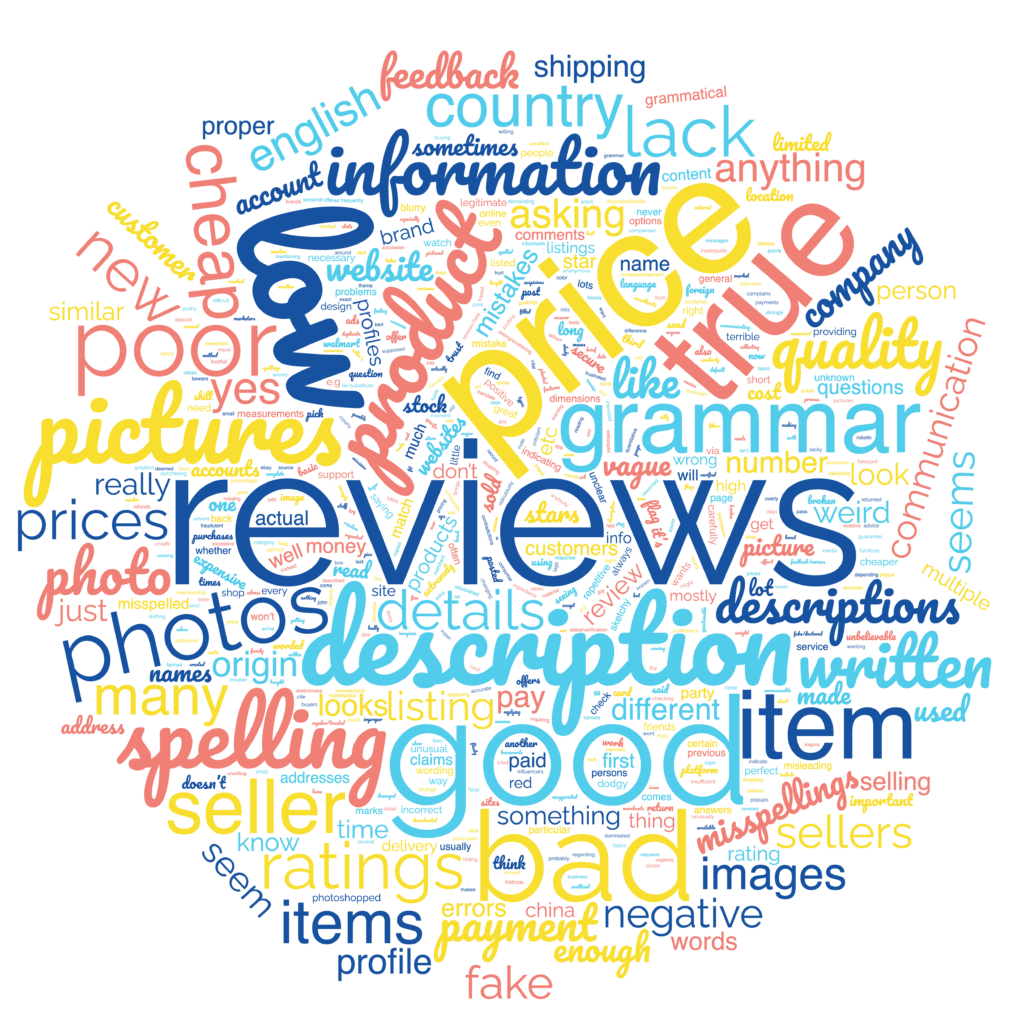
Some of these fall under the umbrella of the previous questions we asked, but it was interesting to see examples of more specific concerns and red flags people look for.
How do you help sellers create attractive marketplace listings?
If anything is clear from this survey, it’s that there are a lot of not-so-great marketplace listings out there. And as has been made abundantly clear, these are less likely to convert.
That’s not good for anyone, including honest sellers who maybe haven’t placed enough importance on the quality of the listing itself. Because not all poor-quality listings are fraud attempts. They do negatively affect trust, though. This is not a face-to-face transaction and therefore the listing becomes the primary interface for the interaction.
So how do you ensure that your sellers create attractive listings that buyers are more likely to be interested in?
Aside from preventing outright fraud or misleading content, a marketplace can benefit from guiding users as much as possible. Help your sellers create better listings. But how?
Make it crystal clear what a good product image is, and what should be included in descriptions, detect issues with grammar and spelling, and encourage honest reviews if your platform supports that. Build it into your interface.
It’s a win-win scenario, so explain why. Why it matters. The magic word here is “because”. Good images are great because… A detailed description is important because… Use effective microcopy and/or other guidance when sellers create or edit their listings.
If you want to learn a bit more about the power of the word “because”, there’s a classic example from way back in the day on how effective it is when trying to convince people to do something. It’s pure behavioral psychology.
Don’t expect people to read a manual. Most won’t. Odds are you are well aware of this already. So, the more integrated the help is in your actual interface, the better. The more self-explanatory and automated, the better. It will also cut down on your support, so that’s another plus.
And, the final bonus, is that you are likely to increase the revenue of your platform if your listings gain in quality. Hard to argue with that, right?
Or, maybe we should say, help your sellers create better listings because it will grow your bottom line.
The role of content moderation on marketplaces
The purpose of content moderation for an online marketplace can have a multitude of functions, but essentially it’s there to ensure that the quality of the user-generated content adheres to the standards of the platform and that end users are protected against abuse and fraudulent behavior.
This includes the content in everything from listings and reviews and any other on-platform communication you have between sellers and buyers.
Content moderation is usually a well-integrated part of the platform itself, whether provided with the help of a content moderation partner (such as us, Besedo) or completely in-house.
There are real challenges to maintaining good content moderation that benefits and doesn’t frustrate users. But nevertheless, it’s critical to do well, something we are very familiar with having been in the content moderation business since 2002.
How comfortable are people with content moderation on marketplaces?
Content quality in listings is key, so it’s a good thing that people on average are comfortable with content moderation on marketplaces. This was very evident in the responses we got to this survey.
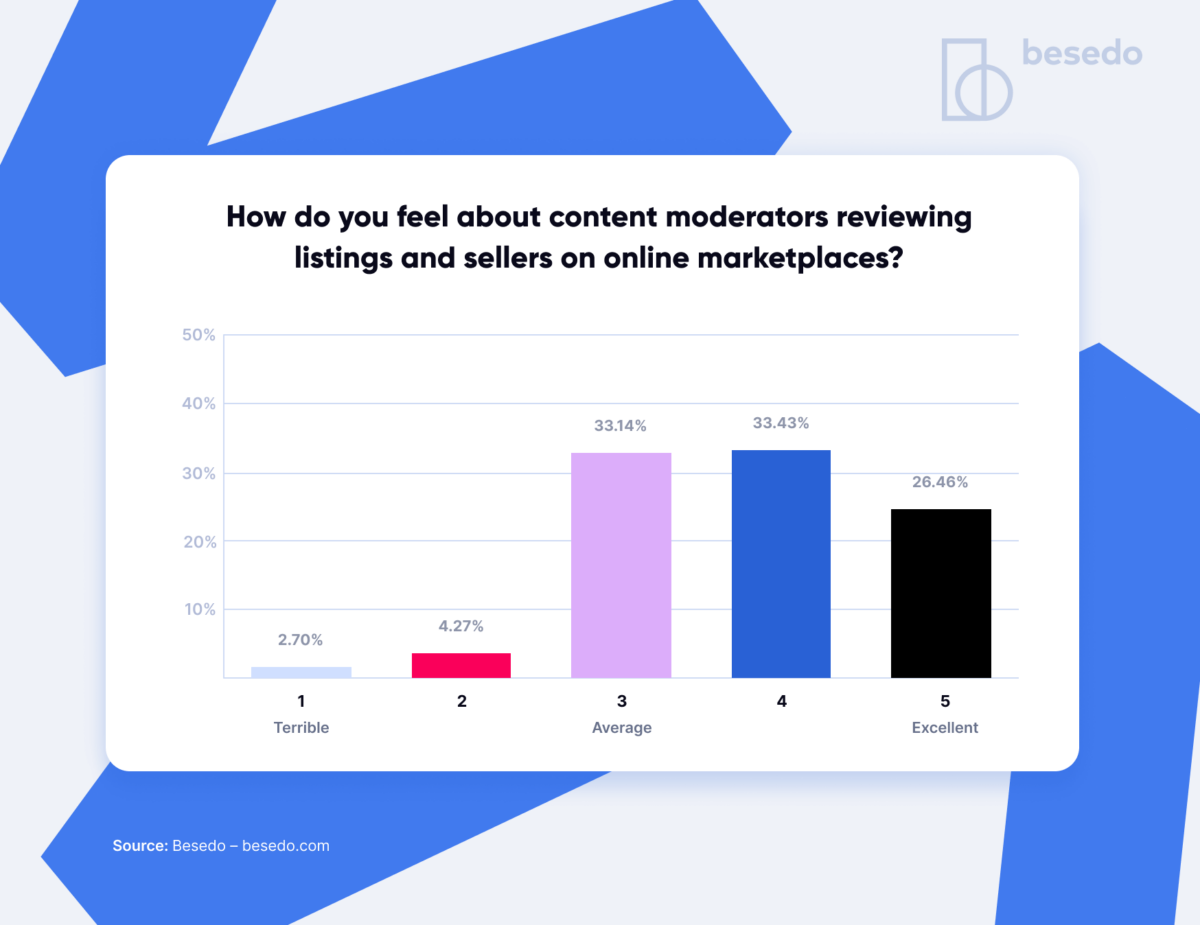
It’s visually apparent by the above chart (another lovely histogram) that there is a clear leaning toward positive sentiment.
- Close to 60% of the respondents reported positive feelings about content moderation on marketplaces, i.e., 4/5 or 5/5.
- That number climbed to 93% if you also included neutral replies (i.e., 3/5).
- Only 2.7% found it “terrible”. Some other time it might be interesting to dive into why this number isn’t 0.
As you can see by the other responses about the connection between the quality of listings and people’s willingness to purchase (their trust in a listing), there’s a clear alignment of interests here.
Transparency of content moderation efforts and policies
Although the vast majority of people we asked thought content moderation was good, more than half of the people asked were unaware of the content moderation policies and practices on the marketplaces they use.
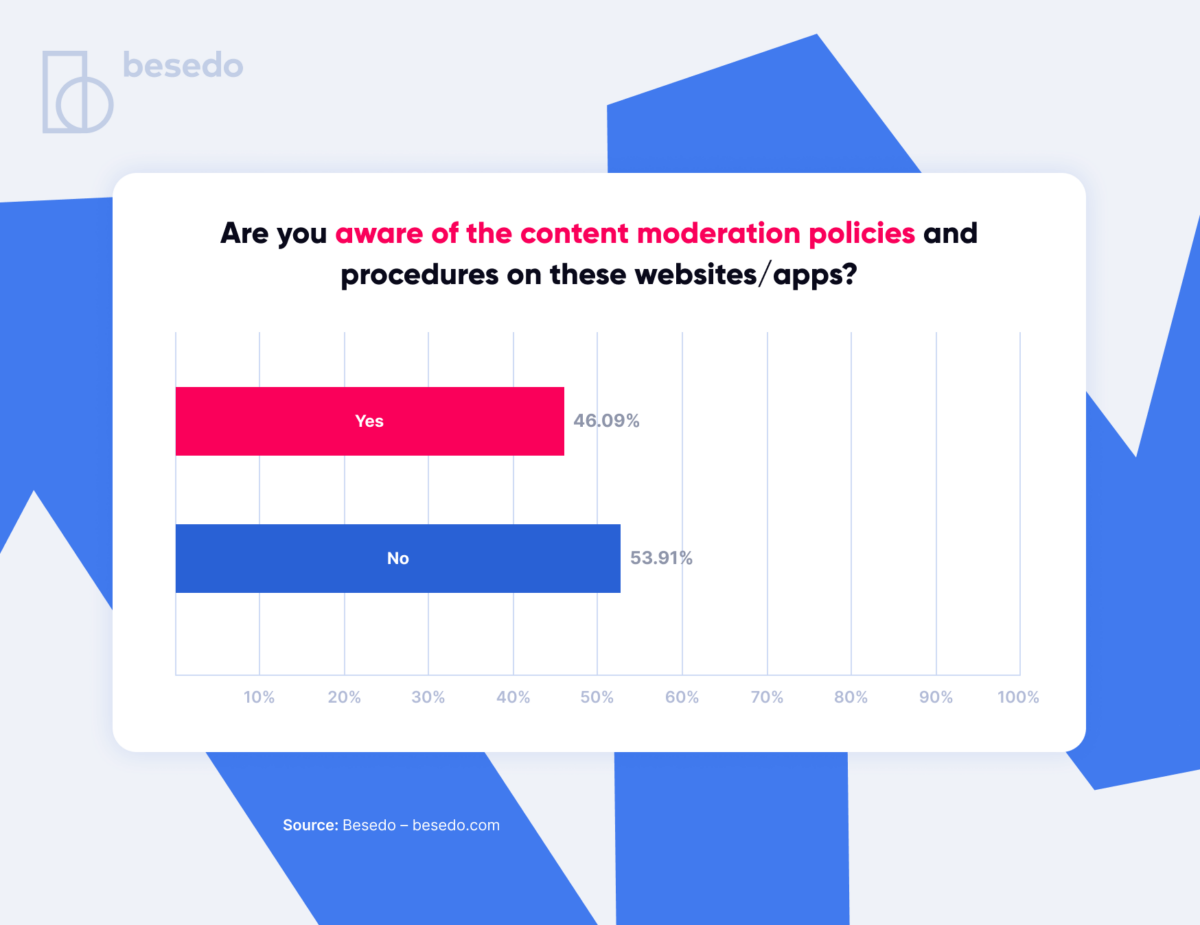
So, if you do put pride into your content moderation efforts, don’t be shy about it. Show your users how you are protecting them and the work you’re putting into safeguarding the platform, making it a safe place for both buyers and sellers. It may help grow trust.
To be fair, content moderation shouldn’t be front and center from an end-user perspective. It’s more of a behind-the-scenes, guiding, and filtering function. Ideally it’s invisible. But we still think it’s good that customers are aware that they are in a safe environment and what the rules of engagement are, so to speak.
For a marketplace, providing a safe and engaging buyer experience is critical, which includes effective content moderation. We are clearly biased in our sentiment here, considering the business we are in, but we think nobody would argue this point.
A few notes on user experience
In addition to questions related to trust and safety, we were also interested in the perceived quality of the user experience people have when they’re using online marketplaces.
We have to assume that user experience is going to vary wildly depending on the individual platforms people use. So, think of these responses as industry averages, but they probably skew slightly towards a more positive experience.
Why skewed towards a more positive experience? Because people are likely to over time abandon user experiences they don’t like, especially if alternatives exist.
With that caveat out of the way, here are the responses we collected.
How often do people use online marketplaces?
Turns out, people use online marketplaces a lot.
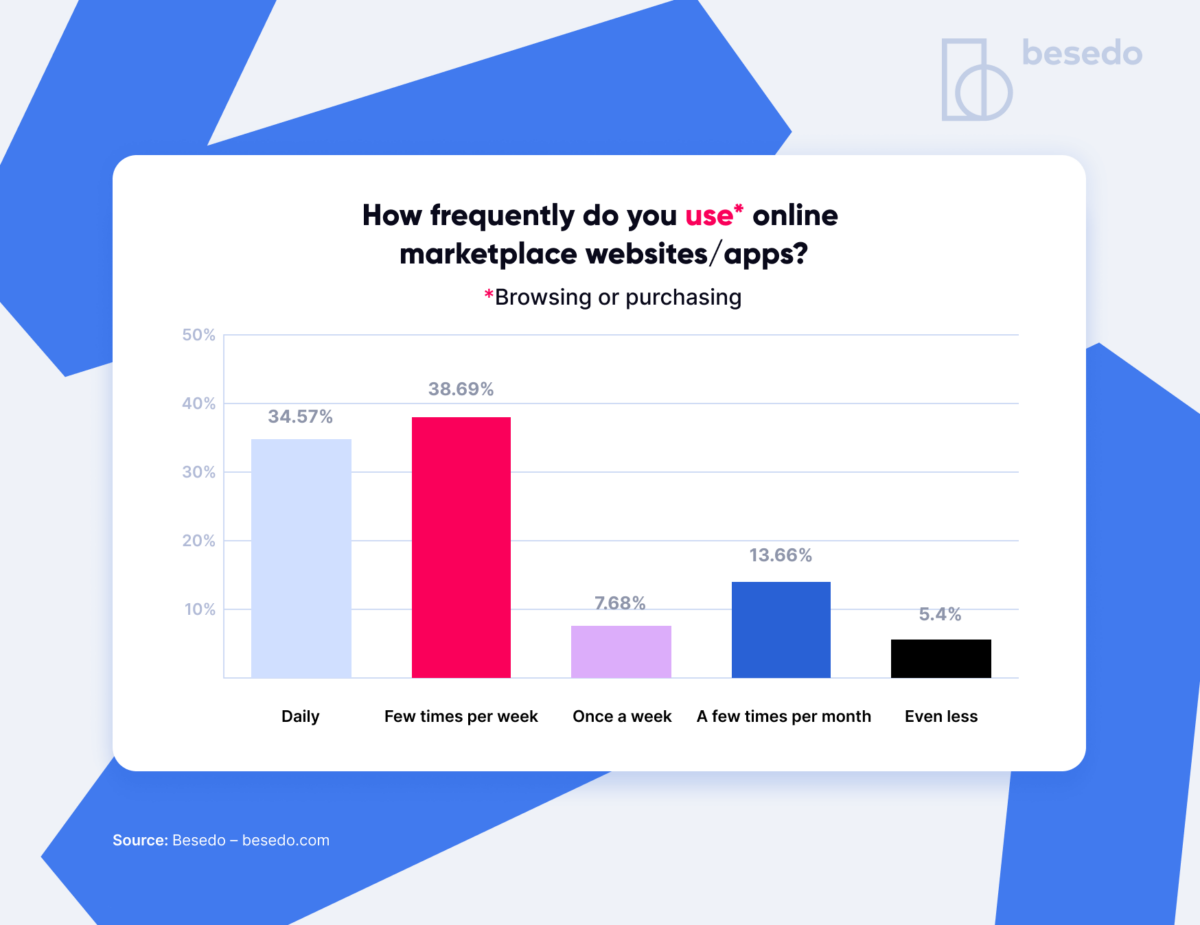
A few things that stand out:
- The median is in the bucket of using online marketplaces a few times per week.
- More than a third of the people we asked use a marketplace website or app daily.
81% use online marketplaces one or more times per week.
How do people rate the overall user experience of online marketplaces?
Although mostly positive, this was a mixed bag of replies that were quite spread out. The most common option was an overall user experience as “average”.
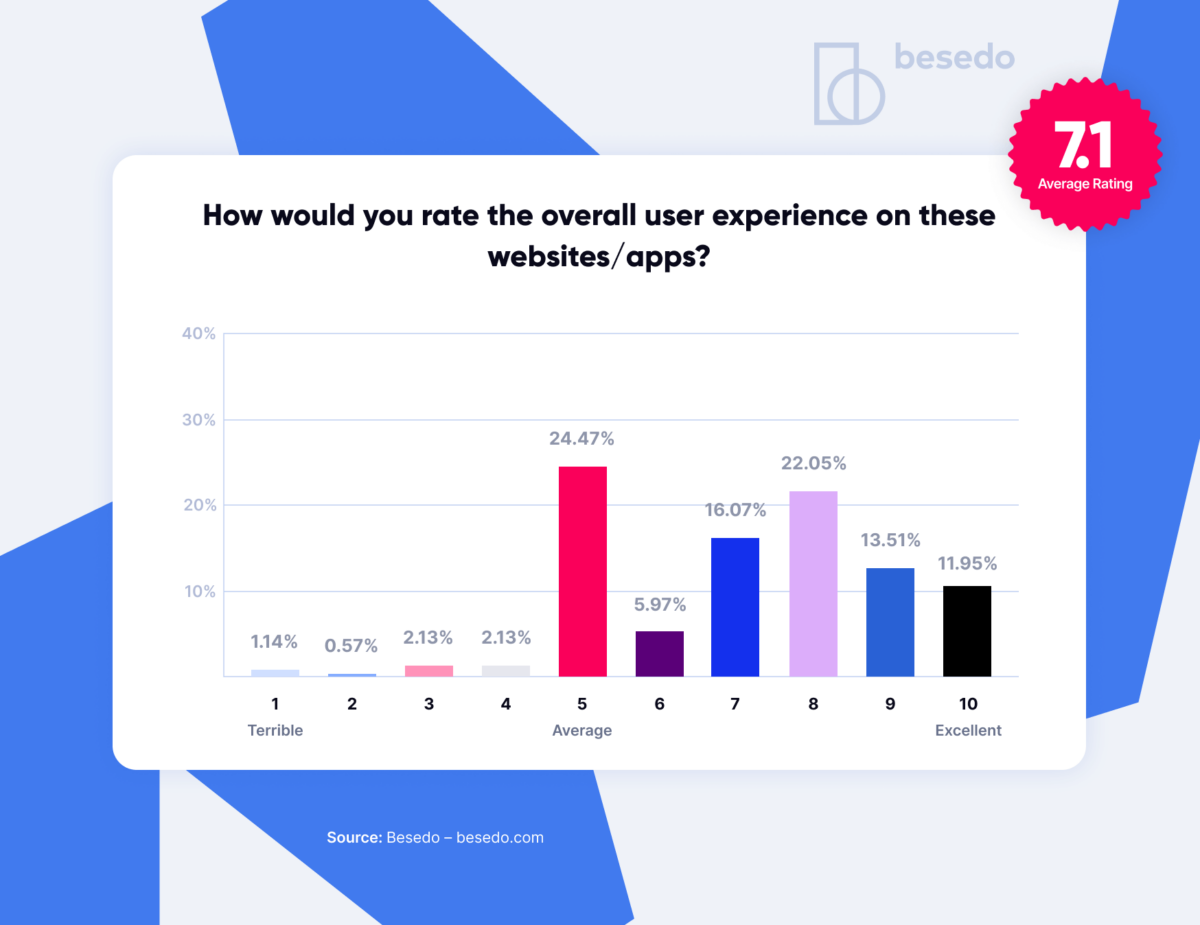
Some observations:
- 24.5% rated the user experience as average, 5 out of 10.
- Only 12% rated the user experience as excellent.
- 70% rated the user experience a 6 or higher.
- 6% rated the user experience a 4 or lower.
How easy or difficult is it to find what they’re looking for?
When using a marketplace website or app, how easy or difficult is it to find what they’re looking for? People are mostly able to navigate these platforms with relative ease, it seems. That said, remember what we said about these numbers likely skewing towards positive impressions since people will over time avoid sites they don’t like using.
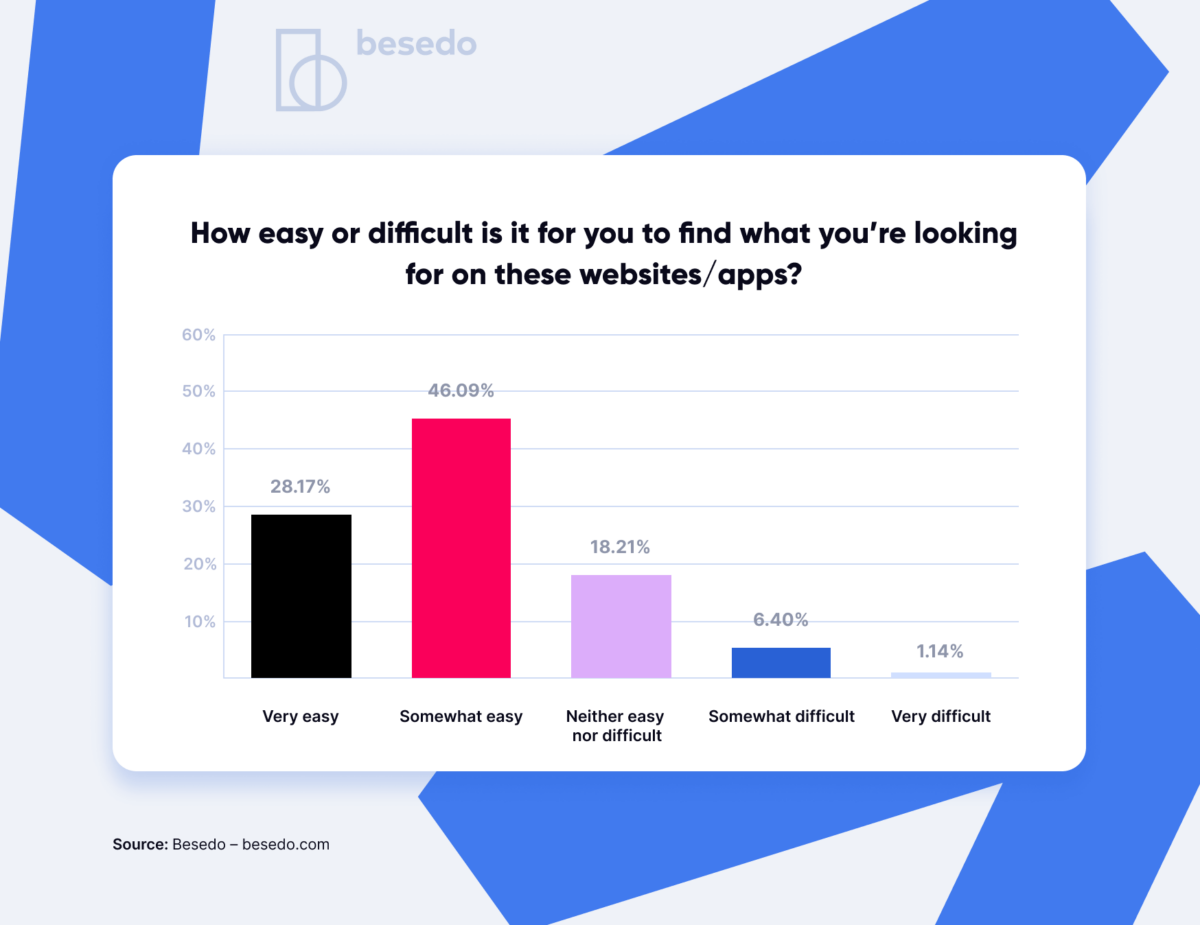
A few observations:
- 74% are able to find what they are looking for very or somewhat easily.
- 7.5% consider it very or somewhat difficult to find what they’re looking for.
- 18% are neutral.
Conclusion
Rarely has the direct connection between Trust and Safety and conversion rates and sales been more apparent than it is on marketplaces and in e-commerce in general.
Buyers and marketplaces are in complete alignment here. It’s clear from the responses we got that consumers are wary of fraud and place a high importance on product listings that are clear and trustworthy. They want great product images, clear product descriptions, and reliable reviews.
If you run an online marketplace where you allow poor-quality content in listings and don’t screen sellers, you risk seriously hurting your bottom line and maybe even your brand.
“With the emerging Digital Services Act (DSA), we expect an even bigger demand from consumers in regards to content moderation transparency. It’s very encouraging to see marketplace users being positive about content moderation,” says Petter Nylander, CEO at Besedo.
So make sure you guide your sellers the best you can and monitor for any scams or poor-quality content in listings, and it becomes a win-win for everyone involved. Happier sellers, happier buyers, and a boost to the bottom line of the marketplace because conversion rates go up as trust increases.
Perhaps easier said than done, but if it were easy, everyone would be doing it. 👋
Press and media inquiries
We hope you found this an interesting and informative read. Please don’t hesitate to reach out if you have any questions about this report or marketplace content moderation.
Methodology
The fine print, the nuts and bolts, or the nitty gritty, if you will: We surveyed 703 individuals aged 18–65 during April and May 2023. All participants acknowledged they had used marketplaces prior to taking the survey. The survey was shared on professional and social networking sites, LinkedIn and Twitter, to reach a broader audience. Countries surveyed include: Sweden, Denmark, France, Germany, Belgium, Netherlands, Spain, Croatia, Italy, Mexico, Colombia, Brazil, South Korea, Australia, the United Kingdom, Canada, and the United States. The data from this method provides a robust foundation for examining the research questions posed in this report, offering a mixture of geographical and professional diversity in the responses.
Ahem… tap, tap… is this thing on? 🎙️
We’re Besedo and we provide content moderation tools and services to companies all over the world. Often behind the scenes.
Want to learn more? Check out our homepage and use cases.
And above all, don’t hesitate to contact us if you have questions or want a demo.





